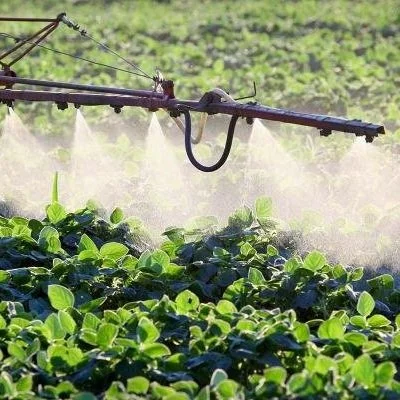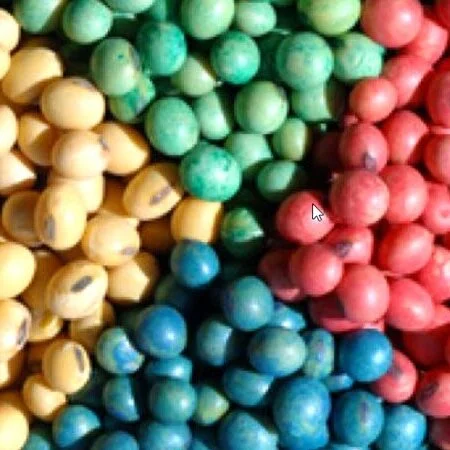Soybean Foliar Fertilizers: Worth The Investment?
With soaring fertilizer prices, farmers are left wondering what the best course of action is for their 2022 nutrient management plan. Cut back on fertilizer? Try out microbial solutions? Bite the bullet and apply full rate?
Emma Matcham, a researcher at University of Wisconsin-Madison, studies soybeans and their response to foliar fertilizer applications. The team’s research was recently published in Agronomy Journal.
Read More
Southwest Airlines Could Soon Be Fueled By Soybeans
Southwest Airlines (SWA) is the latest airline to catch a ride with sustainable aviation fuel. Southwest joins Delta, JetBlue and United in giving sustainable aviation fuel a lift with both short-term and long-term commitments.
Just this week, Southwest Airlines announced by 2030, the airline plans to replace 10% of its total jet fuel consumption with the sustainable aviation fuel.
Read More
Soybean Research Connects Producers/Specialists
LSU AgCenter Soybean specialist Dr. David Mosely is conducting research with variety testing on farm demonstrations around the state.
“Thanks to support from the Louisiana Soybean, Grain Research and Promotion Board, the LSU AgCenter is able to conduct variety testing,” says Moseley.
Read More
How Dredging the Mississippi River Could Uncover $461 Million
Almost half a billion dollars is buried at the bottom of the Mississippi River. A massive effort is underway to dredge the lower Mississippi along its final 250-mile stretch, and the results could provide major financial benefits to U.S. farmers.
At ports along the mouth of the Mississippi, most ships loading soybeans can carry a maximum of 2.4 million bushels, and any additional weight in the hold puts the vessels in danger of scraping the riverbed. However, a mere extra 5' in depth allows a ship to squeeze in 2.9 million bushels, at a small increase in transport costs.
Read More
Oil Becoming New Driver For Soybean Industry
The American farmer has always been at the cutting edge of technological adoption, creativity, ingenuity, and advancement, noted Mac Marshall, vice president of market intelligence for United Soy Board/U.S. Soybean Export Council.
"For us to meet future world demand, making sure that we invest in that technology and the human capital and infrastructure remains absolutely critical," he said.
Read More
Clouds On The Soybean Export Horizon?
Soybean exports for the 2021-22 season did not get off to the best of starts with Hurricane Ida ravaging the Louisiana Gulf Coast and causing significant damage to both humans as well as residential and commercial properties in early September.
Several export facilities were closed for a period of time with Cargill’s Reserve elevator perhaps incurring the worst damage. September is of course, a critical month for the ramping up of U.S. corn/soybean exports and re-building the pipeline. Various reports suggested that as much as 45-50% of the Gulf’s export capacity was impaired for the month.
Read More
130 Bushel Soybeans: How'd They Do It?
Records are made to be broken, and brothers Neil and Blake Culp shattered a big one this harvest.
On Sept. 13, the Culps, who farm in Phillips County, Ark., along with Neil’s wife, Jill, set a state record for soybean yield when they recorded 130.784 bu/a in the annual Grow for the Green Soybean Yield Challenge.
Read More
Corn, Soybeans: Expectations For Tuesday's USDA Reports
On Tuesday, Oct. 12, USDA is expected to release higher ending stocks estimates of U.S. corn and soybeans for 2021-22, revised production estimates for 2020 and lower estimates of U.S. ending wheat stocks. Traders have already reacted to the changes stemming from USDA’s Sept. 30 reports, but may find another surprise or two Tuesday.
Read More
Will Newfound Supplies Threaten Corn, Soy Profits?
Last Thursday’s Quarterly Grain Stocks report from USDA was no doubt an exciting market event, though corn and soybean prices did not escape the trading session unscathed. Indeed, sentiments from the report are continuing to resonate in markets and will likely continue to do so until at least next Tuesday’s October 2021 Crop Production and World Agricultural Supply and Demand Estimates reports.
Read More
History & Significance Of The LA Soybean Breeding & Variety Testing Programs
Relatively new, compared to many of Louisiana’s crops, the soybean was initially adopted in the United States more than 100 years ago as a forage crop. At the time, to find suitable varieties for forage production, university soybean breeders selected varieties out of introductions from Asian countries. Time marches on, and through the decades the LSU AgCenter has helped Louisiana soybean producers adapt to major transformations to production through breeding and variety testing here at home.
Read More
Brazil Is Addition Two Million New Soybean Acres This Growing Season
A lot has been said these past weeks about the increase in the area to be planted to soybean for the next harvest: a jump of more than 2 million acres from last season. That would set a new record for Brazil. Where are those new acres coming from?
This area is distributed between the 5 Brazilian ag regions: MATOPIBA (Maranhão, Tocantins, Piauí and Bahia states), Southeast, South, Midwest and North, as shown in the map below:
Read More
Digital Image Processing Addresses Consistency of Soybean Grading
Soybeans receive a quality grade of 1 through 5 as they enter the supply chain. That grade has implications for contract fulfillment and the price farmers earn for those soybeans – but that rating can be subjective.
Read More
U.S. Farmers Produced More Soybeans, Hold More Stocks, USDA Reports
On Thursday, the USDA pegged the U.S. soybean ending stocks, as of Sept. 1, higher than the trade estimates.
As a result of today's USDA Quarterly Grain Stocks Report, the CME Group’s soybean complex traded lower, following the report.
Read More
The Downside Risk Of Storing Unpriced Crops
With combines rolling across the Midwest, some 20 million bushels of 2021 crop corn and soybeans are quickly filling grain bins. But whether holding crops will actually add to their value remains highly uncertain as an unusual growing season comes to an end.
For starters, despite an export pipeline snarled by storms and the lingering effects of the pandemic, prices are at the best harvest level in a decade. And prospects for rallies face questions about whether China will continue to aggressively buy U.S. grain as its leaders reassert the grip of the Communist Party over the country’s businesses and people.
Read More
'21 Good Soybean Growing Season For Louisiana
This years soybean crop across Louisiana is looking pretty good so far, even with all the challenges growers faced early in the season.
LSU AgCener Soybean Specialist Dr. David Moseley reports we should be close to being 50 percent harvested.
“We’re a little bit behind the five year average and that kind of points back to the slow planting season we had, plus the two hurricanes really slowed down the harvest season.
“But the crop condition is looking pretty good. We were 83% good to excellent with only 4% reported as poor or very poor. But still that’s so much better than we were at the beginning of the season when up to 22% of the crop was poor to very poor.
“So we’ve really had a good growing season overall,” said Moseley.
(This report a service of the Louisiana Soybean Grain Research and Promotion Board)
Read More















